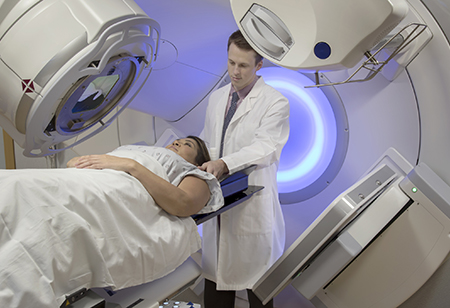If you've been diagnosed with breast cancer, radiation may be part of your treatment plan. And while you may be concerned about the side effects of radiation, today's radiation therapies aren't as daunting as they once were.
"Today's radiation treatment options are more customized and targeted than they were even a decade ago," said Coral Quiet, MD, a radiation oncologist and independent member of the HonorHealth Medical Staff. "In some cases, you can complete radiation treatment in less than one week, with very little down time."
Radiation for breast cancer is typically done after surgery and possibly after chemotherapy. Doctors recommend this order so that the radiation will "mop up" any cancer cells that might remain in the area where your tumor was located. Radiation therapy reduces the chance of the cancer coming back in the targeted area and optimizes cure rates.
Common types of breast cancer radiation therapy
There are two main types of radiation therapy for breast cancer. Here's what you can expect with each:
- Brachytherapy is internal radiation administered by a tiny radioactive pellet. You'll lie comfortably on a table as a catheter delivers the pellet. You won't feel anything as they travel to their targeted site. Treatments are generally about 15 minutes, twice a day for five days. If you have stage 0-2 localized breast cancer and have had a lumpectomy, you may be a candidate for brachytherapy.
- External beam radiation therapy is delivered via specially shaped beams of focused energy; it's similar to getting a chest X-ray during which you won't feel anything. This form of treatment is effective in treating larger areas of the body such as the whole chest area or surrounding lymph node areas. Treatment usually lasts up to six weeks.

Radiation therapy is usually well-tolerated. Short-term side effects might include fatigue, but nearly all patients can continue going about their daily tasks. You may also experience a skin reaction that is probably best described like a sunburn.
"I tell my patients, it's kind of like going to the beach," says Dr. Quiet. "You feel the warmth of the sun, but you don't see its effects until later." Long-term side effects are almost always mild; serious side effects are rare. Damage to the heart and lungs used to be a concern, but modern radiation methods are targeted so those organs are protected.
Preparing for treatments
Dr. Quiet emphasizes the importance of making sure you come to appointments with a list of questions and that you get the answers you need so you and your family members all know what to expect.
She recommends daily exercise, maintaining a healthy diet and keeping an active support system to help you prepare for and recover from breast cancer treatments.
"Even walking 30 minutes a day can bring oxygen into your system and help you maintain muscle mass," says Dr. Quiet. "I also think it's important to make sure you get five to seven servings of fruits and vegetables a day and to decrease processed sugars. And never underestimate the power of a friend running an errand for you or stopping by with a smile and some flowers. These are all healthy practices no matter what you're going through."